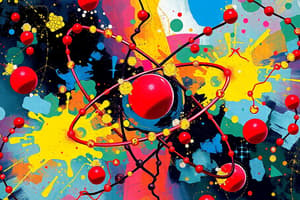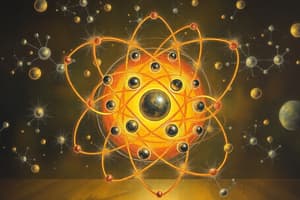Podcast
Questions and Answers
The four elements common to all living organisms are ______, ______, ______, and ______.
The four elements common to all living organisms are ______, ______, ______, and ______.
What is the smallest unit of matter that retains all the chemical properties of an element?
What is the smallest unit of matter that retains all the chemical properties of an element?
Atom
Which of the following is NOT one of the four elements common to all living organisms?
Which of the following is NOT one of the four elements common to all living organisms?
- Calcium (correct)
- Carbon
- Hydrogen
- Oxygen
What are the subatomic particles located in the nucleus of an atom?
What are the subatomic particles located in the nucleus of an atom?
All atoms, regardless of the element, contain protons, neutrons, and electrons.
All atoms, regardless of the element, contain protons, neutrons, and electrons.
What determines an element's atomic number?
What determines an element's atomic number?
What is the term used to describe different atoms of the same element that vary only in their number of neutrons?
What is the term used to describe different atoms of the same element that vary only in their number of neutrons?
What are the two main regions of an atom?
What are the two main regions of an atom?
Electrons contribute significantly to the mass of an atom.
Electrons contribute significantly to the mass of an atom.
How does the arrangement of electrons around the nucleus affect how atoms interact with each other?
How does the arrangement of electrons around the nucleus affect how atoms interact with each other?
The vast majority of an atom's volume is occupied by its nucleus.
The vast majority of an atom's volume is occupied by its nucleus.
Why do solid objects not pass through each other, despite the empty space within atoms?
Why do solid objects not pass through each other, despite the empty space within atoms?
What is the term used to describe the positively charged subatomic particle?
What is the term used to describe the positively charged subatomic particle?
What is the difference between an atom's atomic number and atomic mass number?
What is the difference between an atom's atomic number and atomic mass number?
Atoms of the same element can have different atomic masses.
Atoms of the same element can have different atomic masses.
What is an isotope?
What is an isotope?
Which of the following is an example of an isotope?
Which of the following is an example of an isotope?
How do radioactive isotopes differ from other isotopes?
How do radioactive isotopes differ from other isotopes?
Flashcards
Matter
Matter
Any substance that has mass and occupies space.
Elements
Elements
Unique forms of matter that cannot be broken down further.
Atom
Atom
The smallest unit of an element that retains all of its chemical properties.
Nucleus
Nucleus
Signup and view all the flashcards
Protons
Protons
Signup and view all the flashcards
Neutrons
Neutrons
Signup and view all the flashcards
Electrons
Electrons
Signup and view all the flashcards
Atomic Number
Atomic Number
Signup and view all the flashcards
Isotopes
Isotopes
Signup and view all the flashcards
Atomic Mass Number
Atomic Mass Number
Signup and view all the flashcards
Macromolecule
Macromolecule
Signup and view all the flashcards
Molecule
Molecule
Signup and view all the flashcards
Atomic Mass Unit (amu)
Atomic Mass Unit (amu)
Signup and view all the flashcards
Study Notes
Atomic Structure and Elements
- Atoms are the fundamental units of matter, retaining an element's properties.
- Elements are unique forms of matter, not breakable into simpler substances chemically.
- 98 naturally occurring elements exist; others are laboratory-synthesized.
- Each element is symbolized by a one- or two-letter abbreviation (e.g., C for carbon, Na for sodium).
- Essential elements in living organisms (humans): oxygen (O), carbon (C), hydrogen (H), and nitrogen (N).
- Calcium (Ca) is an important element for humans obtained through diet.
- Trace elements (e.g., iodine) are crucial in small quantities for specific bodily functions.
- Atomic number: determined by the number of protons in an atom, distinguishing one element from another.
- Atomic mass number: sum of protons and neutrons in an atom's nucleus.
- Isotopes: atoms of the same element with varying numbers of neutrons.
Subatomic Particles
- Atoms have a nucleus (center) containing protons and neutrons and electrons orbiting around the nucleus.
- Protons carry a positive charge; neutrons are uncharged.
- Electrons carry a negative charge equal to the positive charge of a proton.
- Protons and neutrons have similar mass (about 1 amu); electrons have considerably less mass.
- Most atoms' volume is empty space.
- Repulsion between negatively charged electron clouds of atoms prevents them from penetrating each other.
Studying That Suits You
Use AI to generate personalized quizzes and flashcards to suit your learning preferences.



